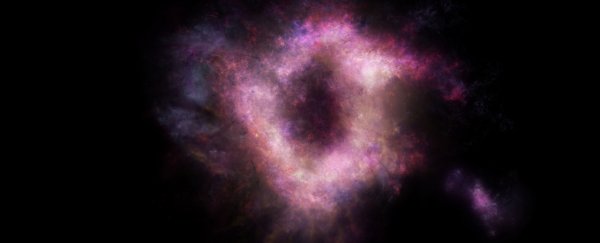In the early days of the Universe, 10.8 billion years ago, astronomers have just found a galaxy wearing the battlescars of a cosmic brawl. It's not a blob or disc of stars, like most galaxies, but a giant doughnut - with a huge hole punched right through its centre.
This classifies it as a rare type of galaxy known as a ring galaxy, and it's rare even among that type - its shape forged not by internal processes, but a collision that saw its core stripped away as the other galaxy passed through.
The galaxy is called R5519, and it's the first collisional ring galaxy ever found more than a few hundred light-years away - which makes it the only known such object in the early Universe.
"It is a very curious object that we've never seen before," said astronomer Tiantian Yuan of the ARC Centre of Excellence for All Sky Astrophysics in 3 Dimensions (ASTRO 3D) in Australia.
"It looks strange and familiar at the same time."
The outer edge of R5519's ring is pretty large, around 42,400 light-years across (on average). The hole punched through the middle is about 17,612 light-years across, with no detectable trace of the star-packed bulge that normally fills a galactic centre.
And there are clues that hint at a violent past.
Some ring galaxies seem to have had relatively peaceful formations, produced by such processes as orbital resonance or the accretion of material from another nearby galaxy.
But the former usually occurs in barred galaxies, and no such bar was observed in R5519; the accretion process shouldn't disrupt the core, as seen in galaxies such as NGC 7742 and Hoag's Object.
In addition, R5519 exhibits a high rate of star formation in its ring - around 80 solar masses' worth of new stars are born every year. This is suggestive of a gravitational disruption - by, say, another galaxy punching through R5519, sending density waves propagating radially outwards.
As these waves push and condense the gas and dust in the galaxy, it triggers star formation by facilitating the gravitational collapse of clumps of dust that turn into baby stars.
 (James Josephides/Swinburne Astronomy Productions)
(James Josephides/Swinburne Astronomy Productions)
In the local Universe, ring galaxies of this type are extremely rare - 1,000 times rarer than ring galaxies formed by less violent processes. The discovery of R5519 suggests, the researchers said, that collisional ring galaxies were as rare in the early Universe as they are in later times.
But it also offers an opportunity to study the formation of disc galaxies like the Milky Way - because in order to form a ring, simulations suggest the galaxy needed to be a thin disc before being punched through.
We didn't think thin disc galaxies formed in the early Universe - most of the galaxies we've found are disordered hot messes, with blobby shapes and stars orbiting in all directions. Nice, orderly discs don't start appearing until around 4 to 6 billion years after the Big Bang, which took place around 13.8 billion years ago.
Last week, astronomers revealed they'd identified a disc galaxy 12.5 billion light-years away, which was pretty mind-blowing. Now the discovery of R5519 10.8 billion light-years away seems to support the idea that discs weren't that rare in the early Universe after all.
"The thin disc is the defining component of spiral galaxies: before it assembled, the galaxies were in a disorderly state, not yet recognisable as spiral galaxies," said astronomer Kenneth Freeman of the Australian National University in Australia.
"In the case of this ring galaxy, we are looking back into the early Universe by 11 billion years, into a time when thin disks were only just assembling. For comparison, the thin disc of our Milky Way began to come together only about 9 billion years ago.
This discovery is an indication that disc assembly in spiral galaxies occurred over a more extended period than previously thought."
The research has been published in Nature Astronomy.
